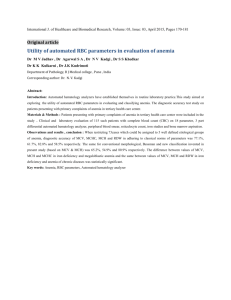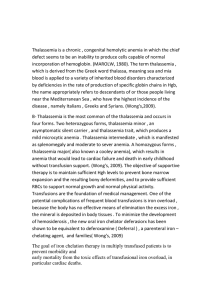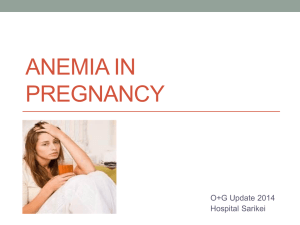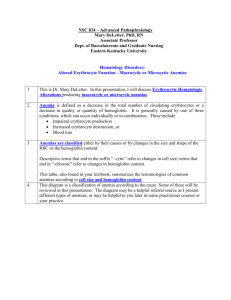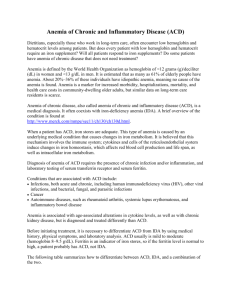PC Mod 2 Study Guide
advertisement
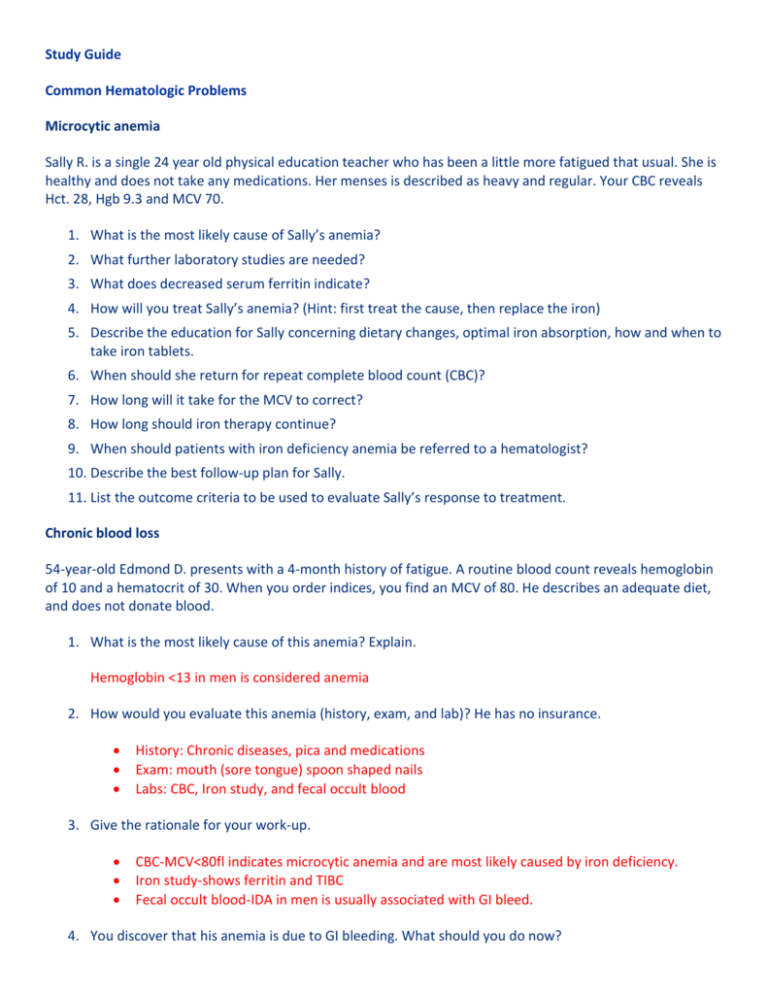
Study Guide Common Hematologic Problems Microcytic anemia Sally R. is a single 24 year old physical education teacher who has been a little more fatigued that usual. She is healthy and does not take any medications. Her menses is described as heavy and regular. Your CBC reveals Hct. 28, Hgb 9.3 and MCV 70. 1. What is the most likely cause of Sally’s anemia? 2. What further laboratory studies are needed? 3. What does decreased serum ferritin indicate? 4. How will you treat Sally’s anemia? (Hint: first treat the cause, then replace the iron) 5. Describe the education for Sally concerning dietary changes, optimal iron absorption, how and when to take iron tablets. 6. When should she return for repeat complete blood count (CBC)? 7. How long will it take for the MCV to correct? 8. How long should iron therapy continue? 9. When should patients with iron deficiency anemia be referred to a hematologist? 10. Describe the best follow-up plan for Sally. 11. List the outcome criteria to be used to evaluate Sally’s response to treatment. Chronic blood loss 54-year-old Edmond D. presents with a 4-month history of fatigue. A routine blood count reveals hemoglobin of 10 and a hematocrit of 30. When you order indices, you find an MCV of 80. He describes an adequate diet, and does not donate blood. 1. What is the most likely cause of this anemia? Explain. Hemoglobin <13 in men is considered anemia 2. How would you evaluate this anemia (history, exam, and lab)? He has no insurance. History: Chronic diseases, pica and medications Exam: mouth (sore tongue) spoon shaped nails Labs: CBC, Iron study, and fecal occult blood 3. Give the rationale for your work-up. CBC-MCV<80fl indicates microcytic anemia and are most likely caused by iron deficiency. Iron study-shows ferritin and TIBC Fecal occult blood-IDA in men is usually associated with GI bleed. 4. You discover that his anemia is due to GI bleeding. What should you do now? Start iron therapy and educate on how to take Refer to GI specialists to determine cause for bleed. Advisable to investigate the colon of all patients over 50 for colonoscopy. Source: http://www.essentialevidenceplus.com.ezproxy.midwives.org/content/ebmg_ebm/315 http://dynaweb.ebscohost.com.ezproxy.midwives.org/Detail?id=AN+240897&sid=08685657-1277-49d7-b8cfb4eb94c082dc@sessionmgr12 Macrocytic Anemia 70-year-old Maggie M. has been a widow for 3 years. She describes herself as depressed and tired and says she no longer has any interest in cooking for herself. She describes some numbness of her extremities. A 24hour diet recall includes tea, white toast with butter, gin, and jellybeans. The hemoglobin is 11 and her MCV is 100. Her folic acid and B12 levels are both low. 1. What are the likely diagnoses? Give your rationale. 2. How would you verify these diagnoses? Explain. 3. Describe the treatment for folate and B12 deficiency. 4. What could happen if you treat with folic acid replacement and she has a B12 deficiency? 5. What other interventions are indicated for Mrs. M.? Rationale? 6. Maggie asks you about oral B12 rather than injections. What will you tell her? 7. List the outcome criteria for evaluating the treatment given Mrs. M. Microcytic Anemia (Thalassemia) 30-year-old Olive R. is a North African immigrant who has a hemoglobin of 11.5, an MCV of 65, and anisocytosis on the peripheral smear. She is generally healthy. 1. What is her most likely diagnosis? Explain. Microlytic anemia- IDA vs Thalassemia (hg, MCV, and anisocytosis indicate either) 2. How should she be evaluated? Give your rationale. Due to ethnicity suspect possible thalassemia Ferritin study (normal in thalassemia) hemoglobin electrophoresis (reference standard) Due to asymptomatic we can avoid unnecessary iron therapy with definitive diagnosis 3. Outline your management. Genetic Counseling β Thalassemia can be cured with bone marrow transplant (text book) 4. How does her ethnicity contribute to your diagnosis? β Thalassemia is more prevalent in people who descend from Africa Source: http://dynaweb.ebscohost.com.ezproxy.midwives.org/Detail?id=AN+240897&sid=cca84694-c04346b3-9b12-16b4402bcc53@sessionmgr12 http://dynaweb.ebscohost.com.ezproxy.midwives.org/Detail?sid=cca84694-c043-46b3-9b1216b4402bcc53@sessionmgr12&vid=&db=dme&ss=AN+%22114765%22&sl=ll Anemia of Chronic Disease 45-year-old Angela has been diagnosed with rheumatoid arthritis. She asks you to recommend treatment for her anemia, as she believes it will help with her fatigue. 1. Assuming Angela has anemia of chronic disease, describe what you expect to find when you look at her CBC, indices, serum iron, serum ferritin, and iron binding capacity. 2. How will you know when you are dealing with anemia of chronic disease versus iron deficiency anemia? 3. Will you treat her with iron? Why or why not?

